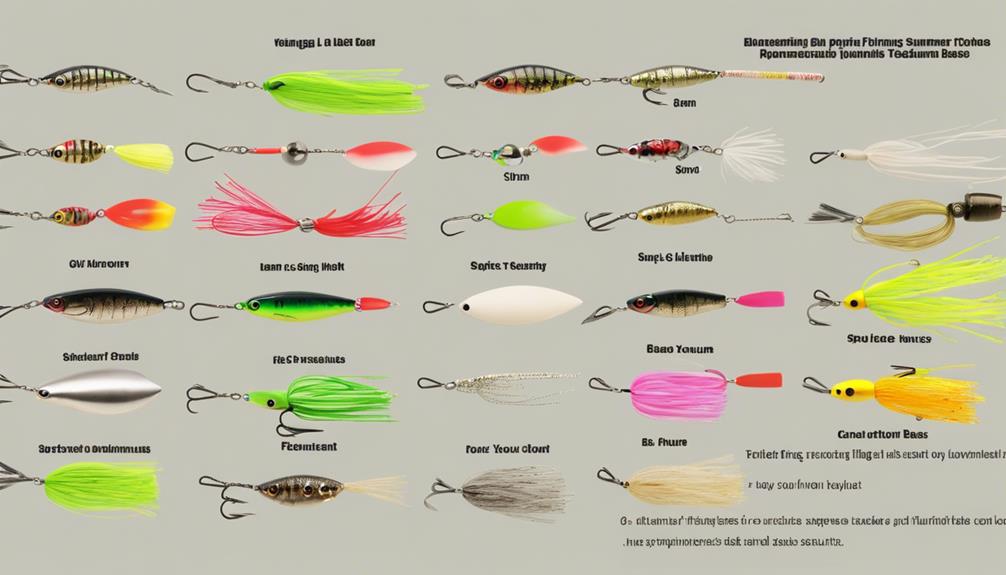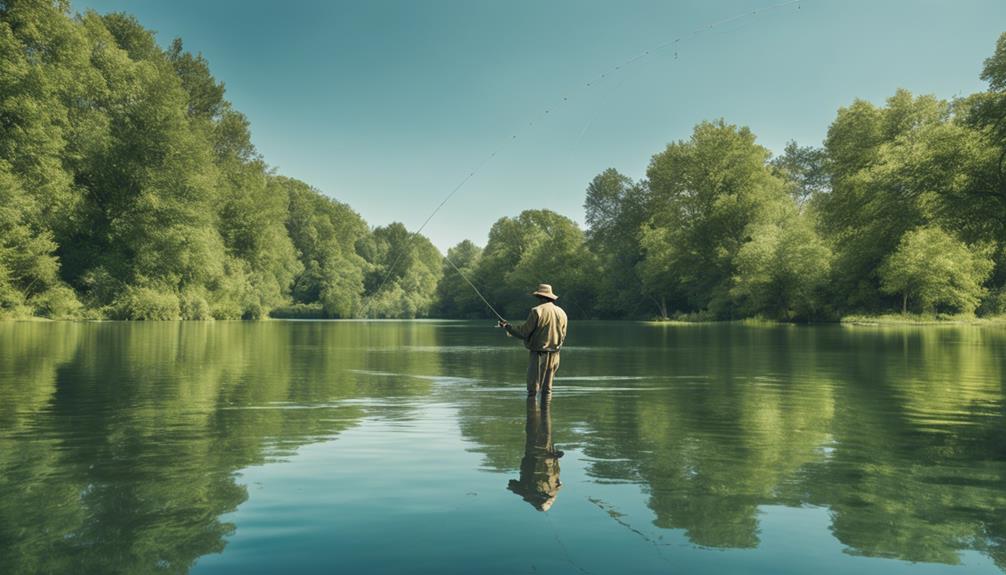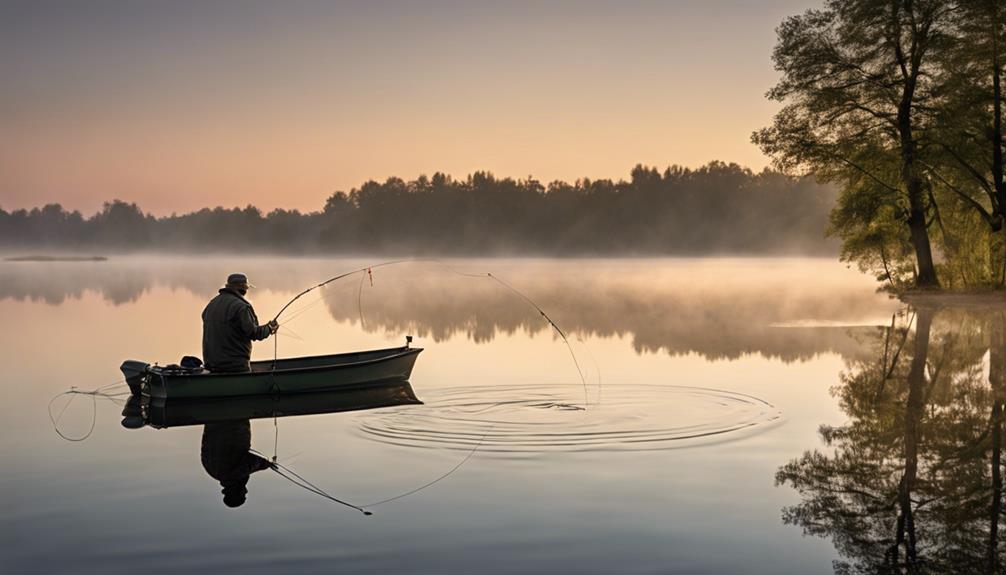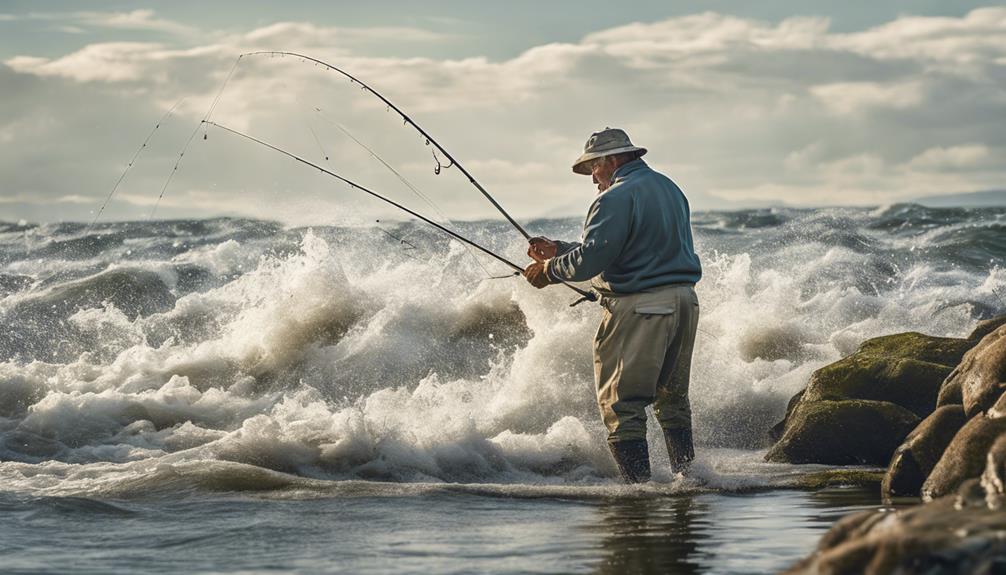Ever wondered how to lure those elusive bass during the scorching summer months? From the gentle ripple of topwater lures to the strategic depth of jigging techniques, mastering the art of bass fishing in the heat requires finesse and know-how.
But what are the remaining six techniques that could make all the difference in your summer bass fishing game? Stay tuned to discover the complete list that will elevate your angling experience to the next level.
Topwater Lures
Are you looking to catch more bass during the summer using topwater lures? When it comes to surface action, there's nothing quite like the thrill of seeing a bass explode on your topwater bait. In clear water conditions, mastering topwater techniques can be highly effective in enticing bass to strike. Here are some tips to help you make the most out of your topwater fishing experience this summer.
To start off, it's essential to choose the right topwater lure for the job. Depending on the conditions, different lures such as poppers, prop baits, or walking baits can be more effective. Experimenting with various styles and colors can help you determine what the bass are keying in on that particular day.
When fishing in clear water, presentation is key. Make sure to cast beyond your target area and work the lure back with a steady retrieve, incorporating pauses and twitches to mimic injured baitfish. Bass in clear water have a keen sense of sight, so a natural and enticing presentation is crucial to trigger their predatory instincts.
Additionally, early mornings and evenings are prime times for topwater action during the summer. Bass are more active during these low-light periods, making them more likely to strike at surface lures. By focusing your efforts during these times, you can increase your chances of landing some exciting topwater bites.
Deep Diving Crankbaits
When targeting bass in deeper waters during the summer, utilizing deep diving crankbaits can be a game-changer for enticing those elusive big bites. These sinking baits are designed to dive down to significant depths, reaching where the bass are holding in the warmer months. The key to success with deep diving crankbaits lies in understanding their swimbaits action – the way they move underwater mimicking real prey.
To effectively use deep diving crankbaits, cast them out and let them sink to the desired depth before starting your retrieve. The erratic movement of these lures can trigger aggressive strikes from bass that are lurking in the depths. Vary your retrieval speed to find what the fish are responding to best – sometimes a fast retrieve with sudden pauses can be more effective than a steady retrieve.
When choosing deep diving crankbaits, opt for colors that resemble the local baitfish in the area you're fishing. Natural hues like shad, bluegill, or crawfish patterns are often successful. Additionally, pay attention to the diving depth range of the crankbait to ensure it reaches the bass you're targeting.
Incorporating deep diving crankbaits into your summer bass fishing arsenal can help you reach fish that are holding in deeper waters, increasing your chances of landing those prized catches.
Jigging Techniques
For effective summer bass fishing, mastering jigging techniques is essential to entice bites from bass in various depths and structures. When it comes to jigging, understanding how to effectively use vertical jigging and finesse presentations can make a significant difference in your success rate.
Here are some key tips to help you improve your jigging game:
- Vertical Jigging: To target bass holding at different depths, mastering the art of vertical jigging is crucial. This technique involves dropping your jig straight down and working it vertically to entice bass lurking near the bottom or suspended in the water column. Experiment with different jig weights and colors to find what works best for the conditions and depth you're fishing.
- Finesse Presentations: In the summer months when bass can be more sluggish, finesse presentations can be incredibly effective. Opt for lighter jigs and subtle movements to mimic natural prey and entice reluctant bass into biting. Using finesse techniques can be particularly fruitful in clear water or when the fish are under less pressure.
- Varied Retrieval Speeds: Bass can be finicky in the summer, so don't be afraid to vary your retrieval speeds when jigging. Sometimes a slow, subtle movement can trigger a strike, while other times a faster, more aggressive jigging action may be needed to get the bass's attention.
- Target Structure: When jigging, focus on targeting structures such as weed edges, rocks, fallen trees, and drop-offs where bass are likely to hide. By presenting your jig near these structures, you increase your chances of enticing a bass to strike.
Flipping and Pitching
Master the art of flipping and pitching to target bass in tight cover and specific areas with precision and accuracy. When bass are hiding in heavy cover like thick vegetation, boat docks, or fallen trees, flipping and pitching are your go-to techniques. These methods involve using a short, stiff rod, heavy line, and a baitcasting reel to make precise casts into tight spots where bass are likely lurking.
To excel at flipping and pitching, practice your precision casting skills. Focus on placing your bait quietly and accurately in the target zone without spooking the fish. Approach each potential bass hideout methodically, presenting your lure in a natural and enticing way. By mastering the technique of flipping and pitching, you increase your chances of enticing bass to strike in challenging environments.
One key advantage of flipping and pitching is the ability to target specific areas where other techniques might struggle to reach. By accurately dropping your bait into pockets within heavy cover, you can tempt bass that are less likely to respond to lures presented in a more conventional manner. Remember to keep your movements controlled and deliberate to avoid alerting the fish to your presence. With practice and patience, flipping and pitching can become your secret weapon for extracting bass from the thickest cover.
Carolina Rig Setup
To effectively set up a Carolina rig for bass fishing, start by assembling the necessary components and adjusting the weight and leader length accordingly. This rig is excellent for finesse fishing with soft plastics, allowing you to cover a lot of water effectively.
Here's how to set up your Carolina rig:
- Select the Right Components:
Choose a bullet-shaped slip sinker based on the depth and current of the water you're fishing in. Opt for a glass or plastic bead to protect the knot on the swivel, and use a barrel swivel to connect your main line to a fluorocarbon leader.
- Adjust Weight and Leader Length:
Experiment with different sinker weights to find the optimal balance between casting distance and maintaining bottom contact. Adjust the leader length between 18 to 36 inches based on the water clarity and the height of vegetation.
- Attach Your Favorite Soft Plastic:
Texas-rig your favorite soft plastic bait onto a wide gap hook. Common choices include creature baits, worms, or lizards. Ensure the bait is rigged weedless to prevent snagging on vegetation.
- Presentation and Retrieval:
Cast the Carolina rig near potential bass hideouts and slowly drag it along the bottom. Feel for any subtle strikes and be ready to set the hook. Experiment with the retrieval speed to find what entices the bass in your fishing spot.
Drop Shotting Tactics
Enhance your bass fishing arsenal with effective drop shotting tactics using lightweight tackle and finesse presentations. When finesse fishing and targeting bass, the drop shot technique can be incredibly productive, especially in clear or pressured waters. This method involves presenting your bait above a weight at varying heights off the lake bottom, enticing bass with a subtle and natural presentation.
To excel at drop shotting, opt for a spinning rod with light line in the 6-10 pound test range. Pair this with a drop shot specific hook, usually in sizes 1-1/0, to ensure proper bait presentation. When targeting bass with finesse fishing techniques like drop shotting, it's crucial to use small, lifelike soft plastic baits such as worms, shad imitations, or small creature baits.
One effective way to employ drop shotting tactics is through vertical jigging, especially in shallow waters where bass may be suspended near structure or cover. By dropping your bait straight down and gently shaking or twitching it, you can entice reluctant bass into striking. Remember to experiment with different bait colors, sizes, and movements to figure out what the fish are keying in on that day.
Incorporating drop shotting into your summer bass fishing repertoire can yield great results, particularly in scenarios where other techniques may not be as effective. Mastering this finesse technique can help you catch more bass when the fishing gets tough.
Spinnerbait Strategies

Utilize effective spinnerbait strategies to target bass in various water conditions and depths. When it comes to spinnerbait fishing, understanding the importance of blade size and trailer choice can significantly impact your success rate.
Here are four key tips to enhance your spinnerbait game:
- Blade Size: Experiment with different blade sizes to see what the bass are most responsive to. Larger blades create more vibration and are ideal for murky waters or when bass are feeding more aggressively. On the other hand, smaller blades work well in clearer waters and under high-pressure conditions.
- Trailer Choice: Selecting the right trailer can make a significant difference in enticing bass to strike. Consider using trailers with curly tails for added action or chunky trailers for a more subtle presentation. Match the trailer color to the skirt for a more natural look.
- Retrieve Speed: Alter your retrieve speed to find the optimal pace that triggers strikes. Sometimes a fast retrieve can trigger reaction strikes, while a slower retrieve may be more effective in enticing hesitant bass.
- Target Structure: Focus on casting your spinnerbait near underwater structures such as rocks, fallen trees, or weed beds. Bass often use these areas as ambush points, making them prime locations to target.
Jerkbait Retrieval Methods
Experiment with varying retrieval speeds to effectively work a jerkbait and entice bass strikes in different water conditions. When using jerkbaits, the key is to mimic injured baitfish to trigger the bass's predatory instincts. One technique is to incorporate twitching pauses during a slow retrieve. This method imitates a wounded baitfish struggling in the water, making it an easy target for bass. By pausing the jerkbait intermittently, you give the bass a chance to strike while creating a realistic presentation.
On the other hand, employing erratic jerks with a steady retrieve can also yield positive results. This action simulates a baitfish darting unpredictably, which can provoke aggressive strikes from bass. The sudden movements catch the attention of nearby fish, enticing them to strike out of impulse. Remember, bass are opportunistic predators, so any unusual movement can trigger their feeding response.
To determine the best retrieval method, consider the water clarity and temperature. In clear water, a more natural and subtle presentation with twitching pauses might be more effective. In murkier water or when the bass are more active, opt for erratic jerks with a steady retrieve to create attention-catching movements. Adjust your technique based on the conditions to maximize your chances of landing a bass.
Frequently Asked Questions
How Do Water Temperature and Weather Conditions Affect Bass Fishing in the Summer?
In the summer, water temperature and weather conditions play a crucial role in bass fishing. Bass tend to move to deeper waters when the temperature rises, seeking cooler environments.
Water clarity affects their visibility and ability to spot bait. Wind speed and cloud cover can impact their feeding behavior, with overcast days often leading to more active feeding.
Understanding these factors can help you adjust your fishing strategy for better success.
What Are Some Common Mistakes Anglers Make When Using Topwater Lures for Bass Fishing?
When using topwater lures for bass fishing, anglers often make mistakes with line selection, retrieval speed, hook size, and rod action.
Choosing the right line weight and type is crucial for casting distance and sensitivity. Varying retrieval speeds can trigger strikes from bass. Selecting the appropriate hook size ensures better hookups. Matching the rod action to the lure type helps in setting the hook effectively.
Mastering these aspects can greatly improve your topwater fishing game.
How Important Is Boat Positioning When Using Deep Diving Crankbaits?
When using deep diving crankbaits, boat positioning is crucial. Your anchor positioning plays a key role in successful structure fishing. Pay attention to wind direction as it affects your casting accuracy.
Can You Provide Tips on How to Effectively Jig for Bass in Heavy Cover?
When jigging for bass in heavy cover, use compact jigs to navigate through dense vegetation. Focus on precise casts, letting the jig sink and then twitching it to imitate a struggling baitfish. Adjust your retrieval speed to avoid snagging.
Opt for weedless jig heads that can slide through vegetation without getting caught. Stay patient and be ready for a sudden strike. In shallow waters, these jigging techniques are vital for success in heavy cover.
What Are Some Alternative Baits to Use for Flipping and Pitching Besides Traditional Plastics?
When flipping and pitching, you have many options beyond just traditional plastics. Live bait options like worms, crawfish, or even minnows can be great choices. If you prefer artificial alternatives, consider using jigs, creature baits, or even topwater lures to entice bass in heavy cover.
Experiment with different baits to see what works best in your fishing situation. Remember, versatility is key when targeting bass in different conditions.
Conclusion
Now that you have learned the top 10 summer bass fishing techniques, it's time to hit the water and put them into action. Remember to stay patient and adapt your tactics based on the conditions and behavior of the fish.
Whether you prefer topwater lures or deep diving crankbaits, there's a technique for every angler. So grab your gear, head out to your favorite fishing spot, and reel in some big bass this summer!



